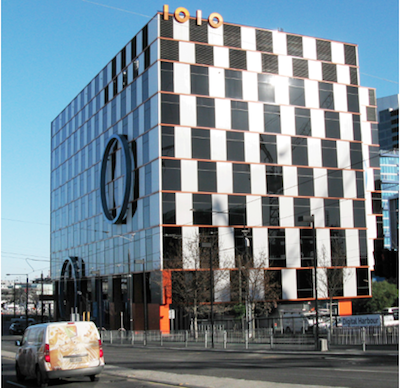Parallel lines sometimes meet
by Burkard Polster and Marty Ross
The Age, 15 August 2011

What a strange office building! Its façade consists of rows of approximately rectangular black and white panels, separated by red lines. The red lines seem to alternately converge and diverge, and a close inspection reveals that the lines actually coincide with the floor levels. Working in this building must be a very interesting experience.
Except, it’s all just an optical illusion. The red lines are in fact parallel, and the black and white panels are exactly rectangular.
You can check it out for yourself, as the building is adjacent to Etihad Stadium, in the Docklands area of Melbourne. An indication that it’s all an illusion is given by the second façade, with the two large circles on the left. This façade appears just as wonky when viewed straight on. However, when viewed slanting away, as in the photo, the illusion is destroyed and the red lines appear properly parallel.
This brilliant optical illusion is known as the café wall illusion. A very nice animation can be found here, where the illusion is dispelled by slowly changing the black tiles to white.
The paradoxical manner in which the red parallel lines appear to converge is a neat twist on a more familiar “paradoxical” observation. Whenever we look at parallel lines running far away from us, they appear to converge at a point “at infinity”. A beautiful illustration of this is given by the railroad tracks in the photo below. (Please ensure that your own railroad tracks are abandoned before attempting to replicate this photo).

This observation is described as paradoxical because it supposedly contradicts the mathematical truism that “parallel lines never meet”. In fact there is no actual contradiction, just a bit of confusion over language.
Nonetheless, parallel lines are genuinely puzzling creatures, which have kept mathematicians occupied for at least two millennia. They are not always as well-behaved as familiar schoolroom lines.
The most famous and important of such puzzles concerns Euclid’s parallel postulate. 2400 years ago, the Greek mathematician Euclid attempted to derive all geometric truth from simple definitions and postulates. The result was the Elements, the most influential maths book ever written. For at least 2000 years, school mathematics was essentially the Elements. It was the model of logical thinking.
In honour of Euclid, we now talk of the Euclidean plane (and more generally, Euclidean space). This is a natural habitat of geometric objects such as lines and circles. It is commonly captured by xy-axes, heading off from each other at right angles.
In the Euclidean plane, straight lines are well-behaved: given a line L, and a point P not on L, there is exactly one line parallel to L that passes through P. This is in effect Euclid’s parallel postulate. However, and this would have shocked Euclid, not all worlds are Euclidean.

Non-Euclidean worlds still contain points and straight lines and angles, but they may behave very differently: angles in a triangle may sum to more or less than 180 degrees; a circle of radius R may have greater or smaller area than πR2; and yes, parallel lines can behave very strangely.
It’s tricky, but in a non-Euclidean world, we can still talk of parallel lines. However, a straight line in such a world may have many lines parallel to it or none at all. Parallel lines still cannot meet (since that’s at least part of what it means to parallel), but in the far distance the lines might come vanishingly close to each other: the illusory world of the train tracks can become real.
But why consider these strange worlds? One reason is for the pure fun of it. Mathematicians love to generalize in this manner, trying to determine what is really possible, and it turns out that much more is possible than Euclid imagined. But there is another reason, almost as important as keeping mathematicians entertained: our Universe is non-Euclidean.
We’ve known for a hundred years, since Albert Einstein, that space itself is fundamentally curved. We wrote a bit about this here. Lines and circles in real space simply do not do behave the way Euclid imagined, and so thinking in a non-Euclidean manner is fundamental to understanding the Universe. More importantly, it is fundamental to understanding the puzzle below, our all-time favourite.
And you thought the façade of that building was weird!
Puzzle to Ponder: A bear leaves his home. He walks 20km South, then 20km East and then 20km North. He finds that he is home! What colour is the bear?
Burkard Polster teaches mathematics at Monash and is the university's resident mathemagician, mathematical juggler, origami expert, bubble-master, shoelace charmer, and Count von Count impersonator.
Marty Ross is a mathematical nomad. His hobby is smashing calculators with a hammer.
Copyright 2004-∞ ![]() All rights reserved.
All rights reserved.